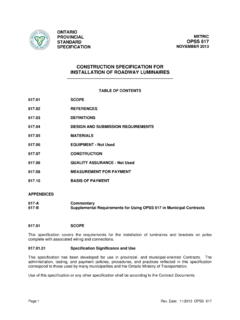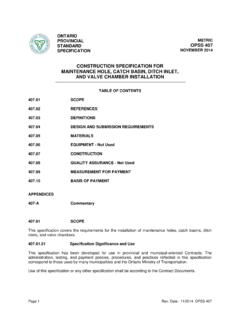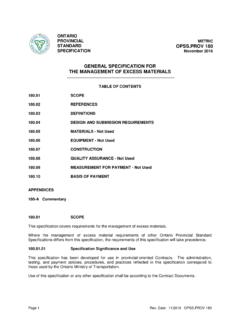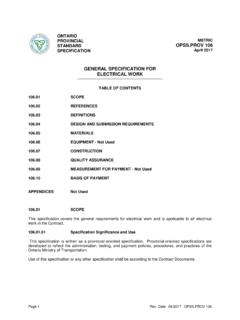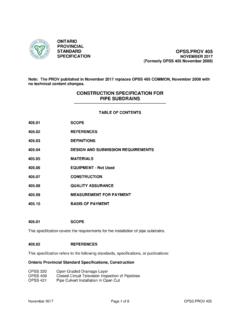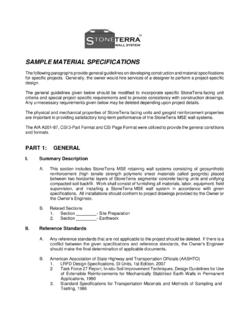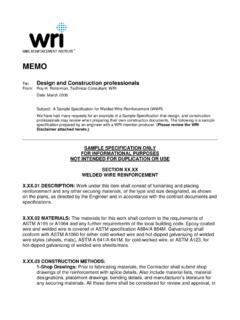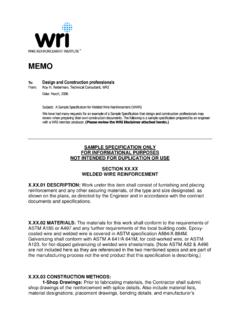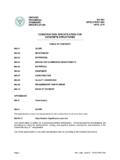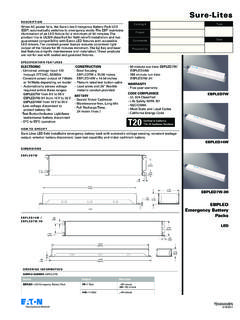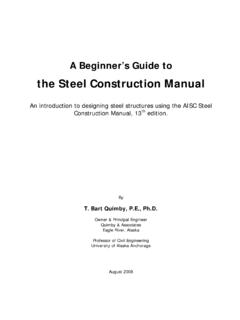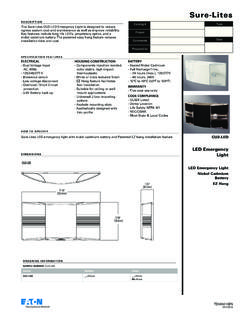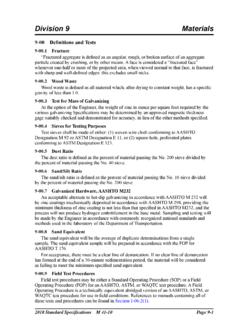Transcription of CONSTRUCTION SPECIFICATION FOR HOT MIX ASPHALT - END RESULT
1 Page 1 Rev. Date: 04/2007 313 ONTARIO PROVINCIAL STANDARD SPECIFICATION 313 APRIL 2007 CONSTRUCTION SPECIFICATION FOR HOT MIX ASPHALT - END RESULT TABLE OF CONTENTS SCOPE REFERENCES DEFINITIONS DESIGN AND SUBMISSION REQUIREMENTS MATERIALS EQUIPMENT CONSTRUCTION QUALITY ASSURANCE MEASUREMENT FOR PAYMENT BASIS OF PAYMENT APPENDICES 313-A Commentary
2 SCOPE This end RESULT SPECIFICATION covers the requirements for the placement, compaction, and acceptance of hot mix ASPHALT . SPECIFICATION Significance and Use This SPECIFICATION is written as a provincial-oriented SPECIFICATION . Provincial-oriented specifications are developed to reflect the administration, testing, and payment policies, procedures, and practices of the Ontario Ministry of Transportation. Use of this SPECIFICATION or any other SPECIFICATION shall be according to the Contract Documents. Page 2 Rev. Date: 04/2007 313 Appendices Significance and Use Appendices are not a mandatory part of this SPECIFICATION unless invoked by the Owner. Appendix 313-A is a commentary appendix to provide designers with information on the use of this SPECIFICATION in a Contract. REFERENCES When the Contract Documents indicate that provincial-oriented specifications are to be used and there is a provincial-oriented SPECIFICATION of the same number as those listed below, references within this SPECIFICATION to an OPSS shall be deemed to mean , unless use of a municipal-oriented SPECIFICATION is specified in the Contract Documents.
3 When there is not a corresponding provincial-oriented SPECIFICATION , the references below shall be considered to be to the OPSS listed, unless use of a municipal-oriented SPECIFICATION is specified in the Contract Documents. This SPECIFICATION refers to the following standards, specifications, or publications: Ontario Provincial Standard Specifications, CONSTRUCTION OPSS 308 Tack Coat Ontario Provincial Standard Specifications, Material OPSS 1101 Performance Graded ASPHALT Cement OPSS 1151 Superpave and Stone Mastic ASPHALT Mixes Ministry of Transportation Publications MTO Laboratory Testing Manual: LS-100 Rounding - off of Test Data and Other Numbers LS-101 Calculation of Per Cent Within Limits LS-264 Theoretical Maximum Relative Density of Bituminous Paving Mixtures LS-282 Quantitative Extraction of ASPHALT Cement and Analysis of Extracted Aggregate from Bituminous Paving Mixtures LS-291 Quantitative Extraction of ASPHALT Cement and Mechanical Analysis of Extracted Aggregate from Bituminous Paving Mixtures - Ontario Procedure LS-292 Quantitative Determination of ASPHALT Cement Content by Ignition and Analysis of Remaining Aggregate From Bituminous Paving Mixtures LS-306 Bulk Relative Density of Compacted Bituminous Mixtures Using Paraffin - Coated Specimens LS-604 Relative Density And Absorption Of Coarse Aggregate LS-605 Relative Density And Absorption Of Fine Aggregate ASTM International D 6752-03 Standard Test Method for Bulk
4 Specific Gravity and Density of Compacted Bituminous Mixtures Using Automatic Vacuum Sealing Method E 178-02 Standard Practice for Dealing With Outlying Observations Page 3 Rev. Date: 04/2007 313 American Association of State Highway and Transportation Officials (AASHTO) M 320-02 Standard SPECIFICATION for Performance Graded ASPHALT Binder R 28-06 Practice for Accelerated Aging of ASPHALT Binder Using Pressurized Aging Vessel (PAV) R 35-04 Superpave Volumetric Design for Hot - Mix ASPHALT T 166-05 Bulk Specific Gravity of Compacted Bituminous Mixtures Using Saturated Surface-Dry Specimens T 240-06 Effect of Heat and Air on a Moving Film of ASPHALT (Rolling Thin Film Oven Test) T 305-97(2001) Determination of Draindown Characteristics in Uncompacted ASPHALT Mixtures T 312-04 Standard Method of Test for Preparing and Determining the Density of Hot-Mix ASPHALT (HMA)
5 Specimens by Means of the Superpave Gyratory Compactor T 313-05 Flexural Creep Stiffness of ASPHALT Binder Using the Bending Beam Rheometer (BBR) T 315-06 Rheological Properties of ASPHALT Binder Using Dynamic Shear Rheometer (DSR) National ASPHALT Paving Association NAPA IS-127 Evaluation of Baghouse Fines for Hot Mix ASPHALT National Center for ASPHALT Technologies NCAT Report 9-8/4 Designing Stone Matrix ASPHALT Mixtures Volume IV - Mixture Design Method, CONSTRUCTION Guidelines, and Quality Control Procedures DEFINITIONS For the purpose of this SPECIFICATION , the following definitions apply: Ambient Air Temperature means the air temperature measured in the shade and away from the paving operations. AMRL means the AASHTO Materials Reference Laboratory. Attribute means one of the following: designated large sieve (DLS), mm sieve, 600 m sieve, 75 m sieve, ASPHALT cement content, air voids, VMA, draindown, or compaction.
6 Binder Course means a HMA course between a surface course and either a granular base course or stabilized base course, an existing pavement, or another HMA binder course. CCIL means the Canadian Council of Independent Laboratories. Class R Roller means self-propelled pneumatic-tired rollers. Class S Roller means self-propelled steel-drum, tandem, or three-wheel rollers. Class V Roller means self-propelled vibratory rollers specifically designed for HMA compaction having either dual vibratory rolls or a combination of vibratory roll and pneumatic tires with a contact area equal to or greater than 70% of the roll width. Designated Large Sieve (DLS) means a sieve size specifically designated for each mix type for gradation testing. The designated sieve for the following mix types is as follows: Page 4 Rev. Date: 04/2007 313 mm for Superpave mm for Superpave mm for SMA , Superpave mm for SMA , Superpave , 1 and 2 mm for SMA , Superpave Draindown means that portion of SMA mixture, fines, and ASPHALT cement that separates and flows downwards through the mixture.
7 Fat Spot means an area of pavement substantially blacker than the surrounding pavement. Field Adjustment to the JMF means a change in the target gradation, ASPHALT cement content, or both of a mix, within limits specified without a redesign of the HMA, resulting in a revised JMF. Hot Mix ASPHALT (HMA) means hot mixed, hot laid asphaltic concrete. The terms are used interchangeably. HMA may include recycled or specialty mixes. Hot Mix ASPHALT Miscellaneous means HMA that is placed in areas other than the roadway, as specified in the Contract Documents. Hot Mix ASPHALT Padding means a HMA layer used for correcting crossfall and profile deficiencies in the existing pavement before placing the levelling, binder, or surface course. Hot Mix ASPHALT Patching means a HMA surface course placed over localized areas of distressed pavement, generally for the purpose of improving strength, rideability, or safety.
8 Independent Laboratory means a third party laboratory that is not owned or corporately affiliated with the laboratory that prepared the mix design or with the Contractor. Job-Mix Formula (JMF) means the percentage passing on each designated sieve of the total mass of aggregate and the amount of ASPHALT cement as a percentage by mass of the mixture that are based on specified mix design procedures. Joint means a vertical contact between a HMA pavement course and any HMA pavement or any rigid object that exists at the time the HMA is laid. Levelling Course means a HMA course of variable thickness used to eliminate transverse and longitudinal irregularities on an existing surface prior to placing an HMA binder or surface course. Loose Mix means a sample of HMA obtained using plates or other approved means for testing mix properties. Lot means a specific quantity of Material or a specific amount of CONSTRUCTION .
9 Mean means the arithmetic average of the test results within a lot. Medium Segregation means the pavement has significantly more coarse aggregate particles than the surrounding acceptable mat and usually exhibits some lack of surface matrix. Micromilling means the use of a milling machine to restore the riding characteristics of a HMA pavement. Mid-Lane Segregation means a continuous or discontinuous longitudinal streak , typically no greater than 300 mm in width located anywhere across the width of the lane. Page 5 Rev. Date: 04/2007 313 Mix Properties means the percent passing the DLS, mm sieve, 600 m sieve, and 75 m sieve; the ASPHALT cement content; and the voids. Other Segregation means discrete areas or patches of regular, irregular or chevron shape. Outlier means a test RESULT that for a specific significance level is determined by statistical analysis not to be part of the test RESULT population.
10 Paving in Echelon means two or more pavers are used to pave multiple adjacent lanes simultaneously. Payment Adjustment Sieves means the DLS, mm, 600 m, and 75 m aggregate gradation sieves. Per Cent Within Limits (PWL) means an estimate of the percentage of the lot that is within SPECIFICATION limits, determined by using the mean and standard deviation of the lot. Performance Graded ASPHALT Cement (PGAC) means an ASPHALT binder that is produced from petroleum residue, either with or without the addition of non-particulate modifiers, according to AASHTO M 320. Quality Assurance (QA) means a system or series of activities carried out by the Owner to ensure that Materials received from the Contractor meet the requirements specified in the Contract Documents Quality Control (QC) means a system or series of activities carried out by the Contractor to ensure that Materials supplied to the Owner meet the requirements specified in the Contract Documents.
